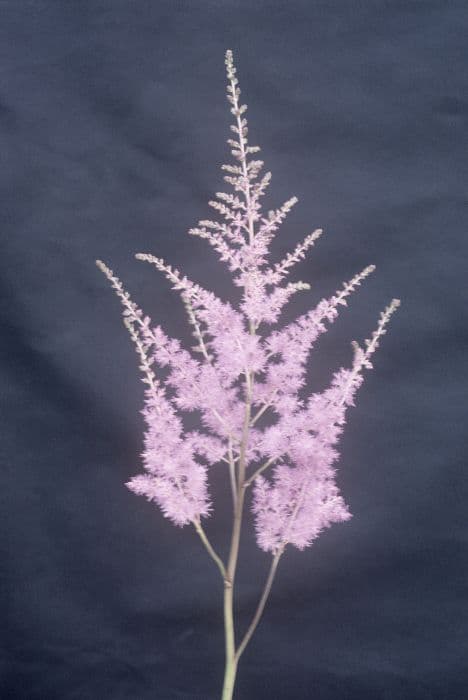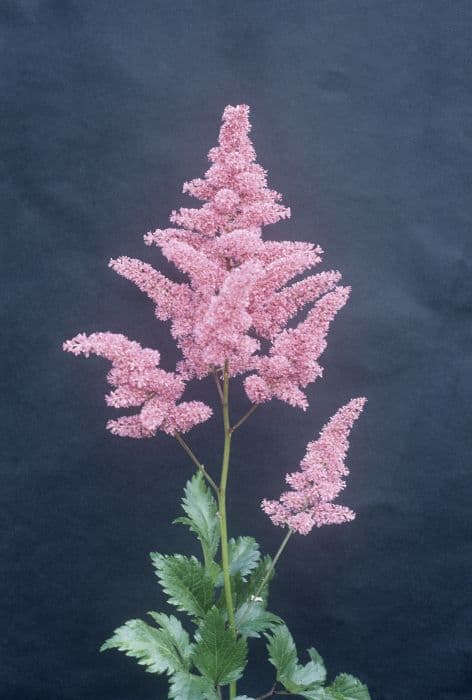Red-leaved Saxifrage Saxifraga 'Rubrifolia' (fortunei) (5)

ABOUT
Saxifraga 'Rubrifolia', commonly known as the Fortune's Saxifrage, is a visually appealing plant that exhibits vibrant foliage and delicate blooms. The plant is noteworthy for its leaves, which have a charming reddish tint, particularly on the underside. This reddish coloration presents a striking contrast to the plant's green upper leaf surface, giving it a two-toned appearance. The leaves are usually rounded with slight scalloping on the edges, growing in a rosette pattern at the base. Throughout its blooming period, the Fortune's Saxifrage produces small, star-shaped flowers that rise on slender stems above the foliage. The flowers are typically white to pale pink with noticeable, contrasting yellowish centers. These blossoms are grouped together in loose clusters and can create a soft, frothy appearance when viewed from a distance. The combination of red-hued foliage and the gentle pastel colors of the flowers makes the Saxifraga 'Rubrifolia' a unique and desirable addition to rock gardens and alpine collections, where its intricate beauty can be admired up close.
About this plant
 Names
NamesFamily
Saxifragaceae
Synonyms
Red-Leaved Saxifrage, Redleaf Saxifrage, Fortune's Saxifrage, Rubrifolia Saxifrage
Common names
Saxifraga fortunei, Saxifraga fortunei var. fortunei.
 Toxicity
ToxicityTo humans
The Red-leafed Saxifrage is not typically known to be toxic to humans. There is no significant evidence of poisoning or serious side effects from ingesting any part of this plant. However, it is generally advised to avoid eating ornamental plants due to potential unpredicted reactions or the presence of garden chemicals.
To pets
The Red-leafed Saxifrage is not commonly known to be toxic to pets either. It is not listed as a toxic plant by major pet poison control resources, and there are no well-documented cases of poisoning in pets from ingesting this plant. As with humans, it's still wise to prevent pets from consuming non-food plants to avoid possible stomach upset or other mild reactions.
 Characteristics
CharacteristicsLife cycle
Perennials
Foliage type
Evergreen
Color of leaves
Green
Flower color
Pink
Height
0.5 feet (15 cm)
Spread
1 foot (30 cm)
Plant type
Herb
Hardiness zones
6
Native area
China
Benefits
 General Benefits
General Benefits- Ornamental Value: Saxifraga 'Rubrifolia', commonly known as Red-leaved Saxifrage, adds visual interest to gardens with its colorful foliage and delicate flowers.
- Low Maintenance: Red-leaved Saxifrage requires minimal care once established, making it suitable for gardeners of all levels of experience.
- Drought Tolerance: Once established, this plant can tolerate periods of dry conditions, reducing the need for constant watering.
- Ground Cover: It can serve as an effective ground cover, filling in spaces and reducing weed growth.
- Rock Gardens Enhancement: Red-leaved Saxifrage is ideal for rock gardens due to its ability to thrive in gravelly or rocky soil.
- Cold Hardy: This plant is capable of withstanding cold temperatures, making it suitable for cooler climates.
- Seasonal Interest: With its season-long foliage and flowering time, Red-leaved Saxifrage offers multi-season interest in the garden.
 Medical Properties
Medical PropertiesThis plant is not used for medical purposes.
 Air-purifying Qualities
Air-purifying QualitiesThis plant is not specifically known for air purifying qualities.
 Other Uses
Other Uses- Saxifraga 'Rubrifolia' can be used in miniature gardening to create a naturalized landscape effect in small-scale settings.
- This plant may be utilized in alpine trough gardens where its hardy nature and attractive foliage can mimic mountainous terrains.
- Its resistance to cold temperatures allows it to be used in frost-themed garden displays, offering persistent color in colder seasons.
- Saxifraga 'Rubrifolia' can be incorporated into green roofing projects to add diversity and visual appeal to eco-friendly building designs.
- As an educational tool, it can showcase plant adaptation and survival strategies in harsh conditions to students and gardening enthusiasts.
- This plant works well in container gardens, especially in hanging baskets where its foliage can cascade over the edges.
- In artistic installations, Saxifraga 'Rubrifolia' can be used to represent or model natural landscapes in miniature or as living art pieces.
- Bonsai enthusiasts might employ it as an accent plant due to its small size and attractive leaves.
- It can be used to create a living mulch in garden beds, helping to retain soil moisture and deter weeds.
- This species is suitable for growing alongside mosses and lichens in a shade garden to create a woodland or forest floor aesthetic.
Interesting Facts
 Feng Shui
Feng ShuiThe plant Saxifraga is not used in Feng Shui practice.
 Zodiac Sign Compitability
Zodiac Sign CompitabilityThe plant Saxifraga is not used in astrology practice.
 Plant Symbolism
Plant Symbolism- Tenacity: Saxifraga 'Rubrifolia', commonly known as Redleaf Saxifrage, often grows in challenging mountainous environments, symbolizing the ability to overcome obstacles and perseverance.
- Strength: The plant's ability to survive in harsh conditions and its sturdy nature represent strength and resilience.
- Persistence: Redleaf Saxifrage's growth pattern, holding tight to rocky surfaces, signifies persistence and determination in face of difficulties.
- Adaptability: This plant adapts to extreme weather and poor soil, embodying the quality of adaptability in adversity.
- Protection: In some cultures, the Saxifraga species is believed to offer protection against negative forces, possibly due to its resilient nature.
 Water
WaterThe Strawberry Begonia prefers consistently moist soil but does not like to sit in waterlogged conditions. Water this plant when the top inch of soil feels dry to the touch, which may be once a week depending on environmental conditions. Use room-temperature water to gently water the soil until it starts to drain out of the bottom of the pot. On average, this might equate to about 16 ounces of water for a small pot. Ensure to reduce watering in the winter months as the plant requires less moisture during this dormant period.
 Light
LightThe Strawberry Begonia thrives in bright, indirect light but can tolerate some shade. Avoid direct sunlight as it can scorch the foliage. A spot near an east or north-facing window is ideal, providing the plant with the gentle morning light or filtered afternoon light. If the light is too intense, consider using a sheer curtain to diffuse the direct sun rays.
 Temperature
TemperatureThe Strawberry Begonia is comfortable in a range of temperatures but favours conditions between 60 to 75 degrees Fahrenheit. It can survive minimum temperatures of about 50 degrees Fahrenheit but should not be exposed to frost. Keeping it in a temperature-controlled room away from cold drafts and extreme heat is ideal for its growth.
 Pruning
PruningPruning the Strawberry Begonia is mainly done to remove dead or yellowing leaves and to maintain its compact, lush appearance. This task should be carried out as needed throughout the year, gently pinching off the unwanted foliage. The best time to prune more extensively is in the spring when the plant is entering its active growth phase, which energizes it for vigorous growth.
 Cleaning
CleaningAs needed
 Soil
SoilThe Strawberry Begonia favors well-draining soil rich in organic matter with a pH range between 6.1 and 7.5. A suitable soil mix can be created using two parts peat, one part loam, and one part perlite, which will ensure good aeration and moisture retention without becoming waterlogged.
 Repotting
RepottingThe Strawberry Begonia should be repotted every 1 to 2 years to refresh the soil and accommodate the growing root system. It is best to repot in the spring, just before the growing season begins.
 Humidity & Misting
Humidity & MistingThe Strawberry Begonia thrives in moderate to high humidity levels, ideally between 50-75%. It can tolerate lower humidity levels, but optimum growth occurs within this range.
 Suitable locations
Suitable locationsIndoor
Place in bright, indirect light and maintain moderate humidity.
Outdoor
Shelter in partial shade, protect from harsh sun and heavy frost.
Hardiness zone
6-9 USDA
 Life cycle
Life cycleSaxifraga 'Rubrifolia', commonly known as Fortune's Saxifrage, typically begins its life cycle as a seed, which, under appropriate conditions of moisture and temperature, germinates to produce a small seedling. The seedling develops into a rosette of leaves close to the ground, which is a characteristic growth form of many Saxifraga species. Through a vegetative phase, it grows and matures, eventually producing stalks of small, star-shaped flowers that are often pinkish to red. After pollination, possibly by insects attracted by the flowers, the plant sets seed. The seeds are then dispersed, naturally or by human intervention, to initiate a new life cycle. Over multiple seasons, Fortune's Saxifraga may also spread asexually by producing offsets from the base of the parent plant.
 Propogation
PropogationPropogation time
Spring-Early Summer
Propogation: Saxifraga 'Rubrifolia', commonly known as Red-leaved Saxifrage, is typically propagated through division. The best time to propagate this plant is in the spring, just as the plant starts to show new growth, or in the early fall after flowering has ceased and the weather is cool. To propagate by division, carefully lift the parent plant from the ground, ensuring minimal root disturbance. Using a sharp knife or spade, delicately divide the clump into smaller sections, each with a good portion of roots and a few shoots. Replant these divided sections at the same depth they were growing previously, spacing them about 6 to 8 inches apart (15 to 20 centimeters), and water thoroughly to help establish them. This method of propagation is straightforward and maintains the desirable characteristics of the parent plant.









